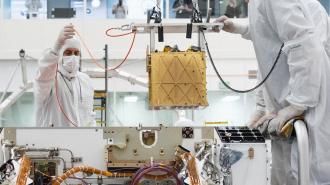NASA has officially wrapped up the Mars Oxygen In Situ Resource Utilization Experiment (MOXIE), which was the first demonstration of oxygen generation on another planet.
“MOXIE’s impressive performance shows that it is feasible to extract oxygen from Mars’ atmosphere — oxygen that could help supply breathable air or rocket propellant to future astronauts,” said NASA Deputy Administrator Pam Melroy.
The challenge: Astronauts will need food, oxygen, and water during missions to the moon and Mars, as well as enough fuel to get them back home, but sending those resources from Earth is hugely expensive.
“Developing technologies that let us use resources on the moon and Mars is critical.”
Pam Melroy
To keep budgets viable, NASA plans for its astronauts to meet some of their needs using resources already available in space, an approach known as “in-situ resource utilization.”
“Developing technologies that let us use resources on the moon and Mars is critical to build a long-term lunar presence, create a robust lunar economy, and allow us to support an initial human exploration campaign to Mars,” said Melroy.
Oxygen on Mars: In April 2021, NASA achieved a huge milestone when MOXIE became the first device to generate oxygen on another world, having hitched a ride to Mars aboard the Perseverance rover in February 2021.
MOXIE generated about as much oxygen as a small dog breathes in 10 hours.
The toaster-sized device did this by heating a sample of Martian air to nearly 1,500 degrees Fahrenheit and then using electricity to split the CO2 in it into oxygen and carbon monoxide (MOXIE’s flashy gold coating ensured the heat from the process wouldn’t damage Percy).
MOXIE has generated oxygen on Mars 15 more times since then, but on September 6, NASA announced that the device’s days of splitting CO2 had come to an end. It also revealed that, during its time on Mars, MOXIE generated a total of 122 grams of oxygen.
That’s only about as much as a small dog breathes in 10 hours, but MOXIE actually outperformed efficiency expectations — NASA’s original goal was for it to generate 6 grams of oxygen at 98% purity or better per hour, and at one point, it was generating 12 grams per hour.
Looking ahead: Now that MOXIE has proven it’s possible to generate oxygen on Mars, NASA can use what it learned from the experiment to start designing a larger system capable of both generating oxygen gas and turning it into liquid oxygen, which could be used as rocket propellant.
Given that a small crew of astronauts would need about 25 to 30 tons of oxygen just to lift off from the Red Planet, NASA expects that this system will need to be able to generate 2,000 to 3,000 grams of oxygen per hour.
At that level of efficiency, NASA could send Big MOXIE — which it expects will be closer to the size of a chest freezer than a toaster — to Mars about two years before a crewed mission and have it generate all of the oxygen the astronauts will need before they even leave Earth.
We’d love to hear from you! If you have a comment about this article or if you have a tip for a future Freethink story, please email us at [email protected].




